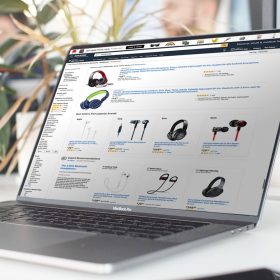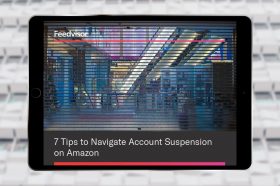Resources - Blog
The Online Retailer’s How-To Guide for a Successful Q4

For most online retailers, the holiday season presents a major opportunity to capitalize on the increase in traffic and sales. As demand is at an annual peak, your success is strongly tied to how well your inventory is managed. Whether it is ordering from suppliers, preparing listings, refining operating logistics, or optimizing replenishment, one thing is certain — you have no choice but to prioritize, and to do so based on your individual operation.
After years of closely studying online seller behavior and buyer trends during the holidays, our team at Feedvisor found that marrying relevant data with best practice tools is the blueprint for an effective Q4 business strategy. We’ve outlined these findings for you in the simple step-by-step guide below.
Stay on top of the latest e-commerce and marketplace trends.
How to Establish a Customized Q4 Calendar
To manage the dramatic rise in demand throughout Q4, it is important to stay on a clear track. Creating and revising a calendar will enable that. With the holiday season limited to only a number of days, a single day of missed opportunity carries significant weight. If you use FBA, you need to have an FBA shipment calendar in place so that you don’t miss any key dates. Building padding around check-in times and fulfillment center transfers is critical to running a smooth Q4 operation.
FBA Seller Tip: Due to an increase in demand and resources, there is an additional lag time in the fulfillment process. Add some extra time for your inventory to become fulfillable. Get your inventory into FBA fulfillment centers at least three weeks in advance. If you want to be in stock for Thanksgiving, Black Friday, and Cyber Monday, ship your inventory out no later than the first week of November.
Non-FBA Seller Tip: If you are running a merchant-fulfilled operation, you should know the lead time it takes to get items ready in your warehouse and plan accordingly. Look at last year’s sales and anticipate when you are going to see sales peaks so you have enough people ready to fulfill orders and maintain high-quality customer service.
If you are a drop shipper, don’t forget to actively and gradually manage your handling days in Seller Central. As the busiest time of the year approaches, shipping services will be overloaded and handling time will increase. Expect a longer lag time for delivering packages, and keep your shipping timelines intact to avoid negative reviews.
For both fulfillment methods, it is important to keep the lines of communication open with your distributors or manufacturers, as their lead time will change during the holidays. Be proactive, especially in establishing new relationships. Start having these conversations now to understand what possible delays or issues you may experience. Take their estimates into account when planning your own transit times, as well as Amazon’s key dates for FBA delivery.
How to Create a Stellar Inventory Strategy
Feedvisor’s data-driven findings indicate a steep rise in demand on Amazon between Q3 and Q4. As a general rule of thumb, you can identify which part of your inventory to focus on by applying the 80/20 rule. Concentrate on the 20% of your catalog which generates 80% of your profits. Our study findings indicate that 40% of revenue comes from your top ten selling items. Start by prioritizing your actions on the key players and create a customized strategy to help them succeed. Once you define a strategy for your inventory, you can prioritize your time on replenishment. The number one thing you can do to kill the Q4 momentum is run out of stock.
During Q4, it is vital to create a planning model that anticipates growth spurts. Look at your month-over-month increases. Notice how your sales are growing month-over-month, and add that to your anticipated holiday growth. Watch the sales rank of your ASINs. If you see a trend of your sales rank getting better over the course of the last few months, you know it is going to carry over into Q4. Make sure you have enough stock to accommodate the probable increase in conversion.
How to Address Your Top Selling Inventory
Feedvisor’s findings reveal that the optimal way to address your top selling inventory is to subcategorize it into three different profiles: seasonal, perennial, and stale. Each of these profiles requires its own goal and strategy. By using these strategies as guidelines, you can ensure the key items do not get overlooked.
Seasonal items: Prepare a template for estimated days in stock. Seasonal items will be in high demand, selling at higher prices for a limited period, so aim for a more precise out-of-stock estimate. To measure your stock coverage accurately, divide the quantity of items in stock by the last seven-day velocity. It might even be a three or four-day velocity.
The important thing is to evaluate your inventory levels by running weekly checks on estimated out-of-stock days and make any necessary adjustments throughout the season. If you calculate the estimated days of coverage and realize it’s after the second week of December, you’ll need to be more aggressive compared to how many units you’re selling. Alternatively, if you see your stock is about to run out, raise the price to slow down the velocity.
Perennial items: Prepare a replenishment plan and create a healthy range of pricing for your top selling items. With the incremental growth in demand, your volume of sales is set to increase. Think about creating a wider price range for your top items, and raise the ceiling price to enhance your profit margin. Prepare a solid replenishment plan. If you normally replenish every two weeks, replenish more to stay on top of things.
Liquidation items: Prepare to go down to competitive floor prices. Long-tail items do not generate profit, so your best bet is to get rid of such “stuck” inventory and clean up your catalog. Assess how these items perform beyond Amazon. They might be unique to Walmart or eBay, so it’s worth trying to sell them on a different channel.
If you are an FBA seller, non-moving inventory is only draining your resources. Consider the time you’re taking to move the inventory, and the increased storage fees you’re paying during this time of year. If an item is at the end of the product life cycle, let it be. Liquidate it by pricing competitively with the market, and use that capital to reinvest in new inventory.
How to Accelerate Your Advertising
Amazon’s advertising platform has made a significant impact on the market this year. Actively advertising on Amazon should be at the heart of every seller’s Q4 strategy. Many sellers get complacent about running promotions ahead of the holiday rush. Their logic is that regardless of the heavy spikes in traffic at this time of year, they don’t need to do anything extra.
Promotions drive sales because holiday shoppers want to feel like they’re getting a good deal. Promotions can also create a halo effect, boosting your sales rank for that ASIN into Q1. The sales momentum generated by Q4 promotions will continue because your sales rank has improved and items are higher up in the Amazon search results.
For all sellers: There are many opportunities you can take advantage of, including Today’s Deals, Lightning Deals, Sponsored Products, and Amazon Coupons. If your business isn’t on social media, you’ll need to add some backbone to your digital presence before the shopping madness kicks in. Creating Twitter, Facebook, and Instagram ads allows you to use social media analytics tools (both free and paid) to identify trends and items people are buzzing about. Social media will ultimately drive more sales through user engagement. Recommendations, ads, promotions, and word-of-mouth all serve to increase brand awareness by widening your reach.
For private label sellers: Advertising is a must! Sponsored Products and Sponsored Brands will serve to increase your exposure during the holidays, so consider increasing your advertising spend during this time of year.
Seller Tip: Managing Sponsored Products is a full-time job. It is pivotal to find the balance between increasing your advertising spend (and thereby increasing your ROI), and not spending too much. Typical seasonal consumer behavior is to shop around and find the best deals, so investigative clicks are bound to happen. Be sure to know your breakeven ACoS, so you can manage your budget accordingly.
How to Streamline Your Priorities Using Data
Whether you are analyzing last year’s orders in preparation for the current year, or reviewing your ad campaign’s weakest keywords, you cannot afford to overlook the goldmine of data available at your fingertips. Effective usage of relevant data points serves to streamline your prioritizations and optimize your impact.
Final Thoughts
Q4 is an exciting time of year. You can maximize your Amazon selling success this holiday season by analyzing data points, strategizing for growth, and focusing on top selling products. Even after all the prioritization and preparation for Q4, the bulk of your work will be keeping up with the logistical and operational aspects of volume increases, as well as actively managing your inventory and reviewing your listings and advertising. Feedvisor’s findings show that sales on Amazon tend to die down on the days just prior to Christmas. Take that time to start thinking about how you’re going to spend January and February managing the season’s returns. Although managing returns from the holidays typically begins January 1, it is never too late to manage return issues on an ongoing basis before they turn into a greater problem.




